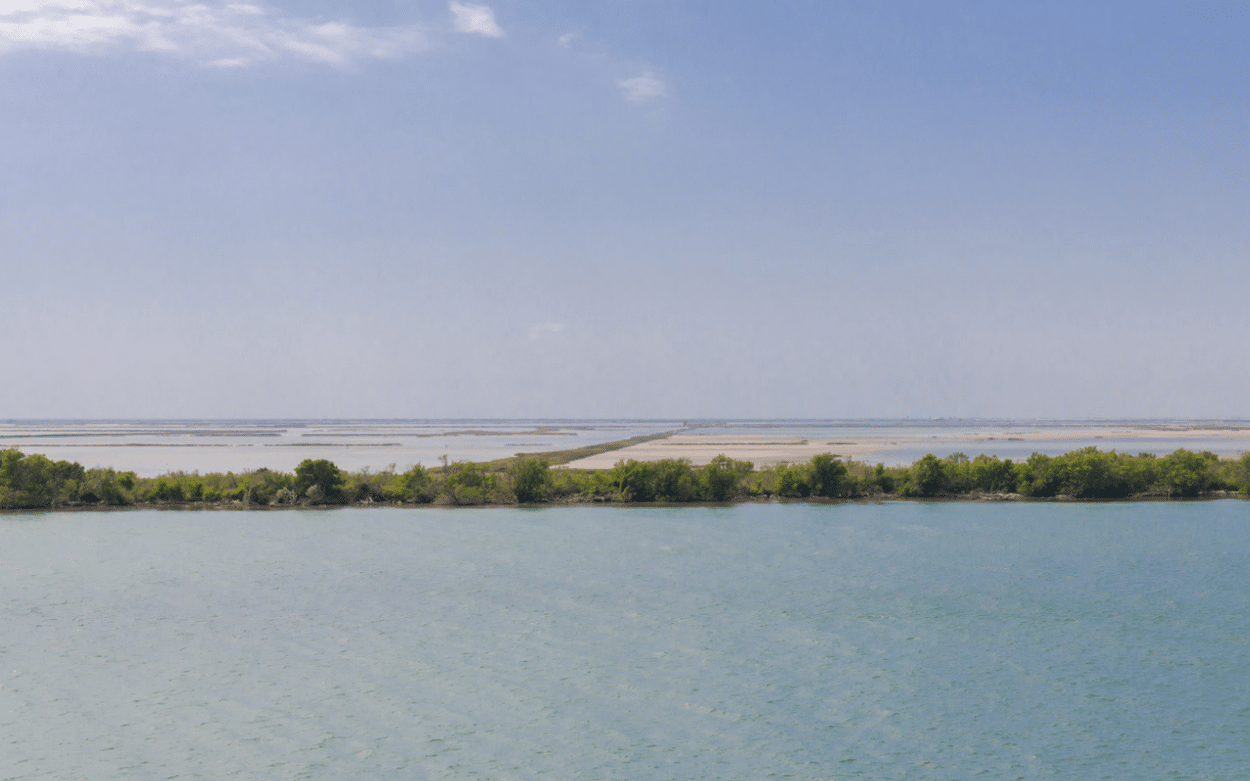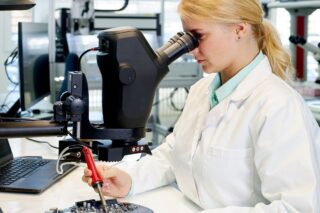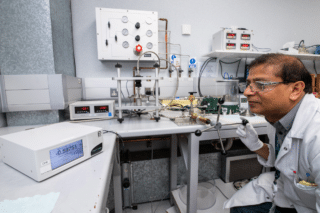French start-up Sweetch Energy has achieved a groundbreaking feat in converting delta seawater into electricity. Their solution harnesses the power of a freshwater-seawater mixture to generate electricity on a significant scale. With plans underway for a pilot site near Marseille, this innovation holds the potential to meet the energy demands of the city, which boasts a population of nearly one million residents. The start-up successfully secured 6 million euros in funding last September, further bolstering this promising endeavor.
The core concept behind Sweetch Energy’s pioneering approach lies in osmotic energy, a natural phenomenon resulting from the salinity disparity between freshwater rivers and seawater. While this form of renewable and clean energy has long been known, its commercial viability had been limited. However, Sweetch Energy’s patented INOD technology has unveiled new horizons of possibility.
The company aims to inaugurate the first large-scale pilot production plant in the Rhône delta, adjacent to Marseille, by the year’s end. Collaborations with industry giants such as Compagnie Nationale du Rhône (CNR) and EDF solidify their commitment to this venture.
To gain deeper insights into the potential of this groundbreaking source of electricity, we spoke with Nicolas Heuzé, CEO and co-founder of Sweetch Energy.

What is osmotic energy and what is its potential?
Nicolas Heuzé: “Osmotic energy holds immense potential as a natural and abundant energy source found in deltas and estuaries worldwide. It is a continuously replenished energy generated by the interaction between freshwater and seawater or ocean water in these regions.
Since the 1950s, industries and researchers have been diligently exploring the possibilities of harnessing osmotic energy, often considered the holy grail of renewable energy. This form of energy offers several compelling advantages, including its clean and renewable nature, significant contribution to decarbonization efforts, and, notably, its consistent availability.
Unlike other renewable energy sources that are subject to weather conditions, osmotic energy remains unaffected by weather fluctuations. As a result, it serves as an excellent complement to existing energy sources such as hydropower, wind power, and solar energy. The scale at which osmotic energy can be harnessed is remarkable. Deltas and estuaries globally release an estimated 30,000 terawatt-hours of osmotic energy annually, surpassing the planet’s electricity demand of approximately 25,000 terawatt-hours per year. While capturing and converting the entire 30,000 terawatt-hours may not be feasible, a significant portion can be effectively utilized in these delta and estuary regions.
When considering global implementation, incorporating natural and industrial sources, osmotic energy has the potential to contribute up to 15% of the world’s electricity. The need for substantial electricity production in the coming years is becoming increasingly evident. This demand extends beyond current expectations, as evidenced by recent findings suggesting that the electricity requirements predicted by RTE just two years ago may have been underestimated. Consequently, global projections indicate that by 2050, approximately half, if not more, of the electricity production, will still rely on gas and coal. Achieving the ambitious goals of zero carbon emissions and complete decarbonization of energy production remains a distant reality.”


If this energy has so many benefits what has not it been extensively exploited?
Nicolas Heuzé: “The production of osmotic energy is a complex process with several challenges to overcome. Initially, the most efficient method to harness this energy involved the use of a membrane placed between the flow of freshwater and seawater. While both flows naturally tend to mix, a selective membrane allows only cations or anions to pass through. This separation of ions, with cations on one side and anions on the other, creates a setup similar to a battery, where electrodes at the ends generate electricity. This mechanical approach represented the first-generation technology developed for capturing osmotic energy. However, it proved to be highly inefficient and costly.
The second-generation technology, which we are currently working on, involves the use of an ion-selective membrane. This membrane selectively transports ions and eliminates the need for mechanical components. Instead, it enables the direct generation of electrical current within the system.
This approach has been the focus of researchers and experts in osmotic energy for the past two or three decades. Despite the progress made, there are still significant challenges to address, particularly regarding the membranes used in the process.
The inefficiency of previous membranes stemmed from their reliance on a classical sieve-like effect, where the mesh size had to be extremely small to allow the passage of specific elements. Meshes on the order of angstroms or picometers, ranging from 10^-11 to 10^-12, were utilized for selective ion transport. While such small mesh sizes ensured high selectivity and separation of ions, they also resulted in slow separation processes and limited ion circulation, leading to a significantly low osmotic current. Consequently, capturing a substantial amount of energy required deploying massive quantities of membranes with extensive surface areas.
Additionally, the cost of these membranes has been a major barrier to large-scale implementation. The membranes used in early attempts were conventional polymer membranes and their cost reached several tens or even hundreds of euros per square meter.
The combination of low performance and high costs associated with these membranes has limited their practical viability for large-scale deployment of osmotic energy technologies. As a result, developing more efficient and cost-effective membranes remains a crucial challenge in advancing osmotic energy production.”


This is where you come into play. You have developed the INOD technology to overcome these challenges. Can you give us more details about it?
Nicolas Heuzé: “A new scientific phenomenon was discovered about a decade ago by teams from CNRS, led by Professor Lydéric Bocquet, a prominent French physicist who is a member of the Academy of Sciences. He and his team discovered that within a nanoscale mesh membrane, which is about 10^-9 in size, 100 to 1000 times larger than what was previously achieved, it was possible to be selective and generate significant ionic currents.
This discovery may seem counterintuitive because it’s like saying that in a warehouse of ten thousand square meters, you can select an element of one centimeter. Yet, they observed on boron nitride nanotubes that it is indeed possible to be highly selective and generate ionic currents on a tremendously larger scale compared to previous achievements.
At this scale, surface phenomena come into play and enable this selectivity. These larger mesh membranes allow for selectivity and faster ion circulation, thus generating much more substantial ionic currents. This is called nano osmotic diffusion and represents the scientific breakthrough, the fundamental discovery on which our technology is based.
In 2015, we created Sweetch Energy with the goal of developing a new system that would implement this nano-osmotic diffusion phenomenon. However, the challenge was to transition from nanotubes, which are one-thousandth the diameter of a hair, to a full-scale membrane.
For over five years, we worked to identify the appropriate material and process to implement this phenomenon and manufacture cost-effective membranes. We also aimed to be environmentally friendly and we found a clean material that does not rely on rare earth elements.”

What is this biomaterial?
Nicolas Heuzé: “This biomaterial, for which we cannot disclose the details, is inexpensive and widely used in the industry. There is a considerable amount of highly secretive and specialized knowledge surrounding the development of this membrane. Scaling up is facilitated by the fact that we can implement manufacturing processes for this biomaterial that are already known in the industry. Moreover, it is readily available in very large quantities and locally sourced.
As a result, we have new membranes that are significantly more efficient. At the laboratory scale, these membranes demonstrate performances that are over twenty times superior to the previous generation, with costs that are five to ten times lower than the older membrane generations.
To quantify performance, we refer to power density, which measures the power output per square meter of membrane in operation.”


To prove these performances, you are launching a pilot site in the Rhone River. Can you provide more details about your expectations for this site?
Nicolas Heuzé: “Our focus is on the large-scale deployment of osmotic energy in deltas and estuaries, starting in the Rhône region of France. The potential for installation is approximately 500 megawatts, equivalent to half a nuclear power plant, which could power around 1.5 million people. The pilot plant, located near Marseille in Port Saint Louis, is expected to be operational by the end of this year or early next year, generating tens of kilowatts of power. The initial investment for this phase is three million euros. The goal is to quickly validate the technology, its functionality, and its real-world performance.
Over the past year and a half, we’ve collaborated with the Compagnie Nationale du Rhône to develop osmotic energy on a large scale. We also have a partnership with EDF Hydro for other sites in France. In the coming weeks and months, we’ll announce further deployments of osmotic energy in France.”

Is the deployment process straightforward? What equipment is required?
Nicolas Heuzé: “Our INOD technology is designed to be fully modular. Each osmotic energy module consists of a small unit where freshwater and saltwater, separated by membranes, are introduced. The modular design allows for rapid deployment, starting with initial units and expanding the site gradually. This flexibility is crucial.
Osmotic stations are not built like dams across rivers. They can be installed on estuary banks, barges, or levees. Freshwater is sourced from the river, while saltwater is obtained from the sea. Infrastructure, including pumps and pipes, is in place to transport the water. The modules, each measuring 50 cm by 50 cm, are installed inside the system. The power output increases with the number of modules used. Water flows gently through these modules without any pressure, noise, smoke, or machinery. It’s a gentle and environmentally friendly energy source. The water eventually mixes within the system and is returned to the estuary. No water is extracted from the natural environment, ensuring minimal impact on the river, sea, or estuary.”


What powers the system?
Nicolas Heuzé: “A small amount of energy is used to bring water into the system. The system operates through ion exchange between the membranes and the gentle flow of the two water streams along the membranes. There is no pressurization involved. The ionic current generated within the membranes is captured and converted into electricity by electrodes. It’s a unique system that doesn’t rely on rotating mechanisms or heat generation. Instead, it harnesses the movement of ions between fresh and saltwater within the membranes. This process is environmentally friendly and has no impact on biodiversity.
Environmental acceptability is essential for deploying this technology. We are working with EDF and a group of architects to design harmonious osmotic plants that seamlessly blend with the natural surroundings. At Viva Tech, we presented the concept of placing the plants on barges, with the equipment installed vertically underwater to minimize visual impact.”

Can osmotic energy be produced outside of deltas and estuaries?
Nicolas Heuzé: “Natural osmotic energy is generated in deltas and estuaries where there is a salinity gradient between freshwater and saltwater flows. However, we are also exploring other sources of salinity gradients, such as mines and industrial sites. The European Union funds our efforts to develop a technological component that artificially generates salinity gradients using low-temperature waste heat.
Low-temperature waste heat, typically below 100 degrees Celsius, is a vast source of untapped energy. Although we currently lack the ability to generate electricity at such temperatures, it represents approximately 1,000 terawatt-hours of wasted energy in France alone. To put it into perspective, France’s electricity consumption ranges between 450 and 500 terawatt-hours. So, if we can capture and convert even 20% of this energy with good efficiency in the future, it could account for 10% of France’s electricity consumption.”


What about the price of osmotic energy?
Nicolas Heuzé: “Our primary objective at Sweetch Energy is to make osmotic energy competitive in terms of pricing. We are committed to deploying osmotic energy at a competitive price and driving the transition to an industrial society.”

Do rising sea levels and watercourse depletion pose challenges?
Nicolas Heuzé: “Rising sea levels are a long-term phenomenon that does not significantly impact osmotic energy. The availability of freshwater is the key factor, and it can be a limiting factor in some cases. While certain watercourses may experience decreasing flow rates over time, we plan for extremely long timeframes. Even with reduced water flow in the Rhône River, for example, our osmotic plants are designed to handle it. We install up to five hundred cubic meters, ensuring we have ample capacity for deployment. Since osmotic energy is not yet widely utilized, any decrease in water flow becomes a concern only when osmotic energy has already been massively deployed. So, while it may theoretically become a challenge in the future, we have sufficient potential for deployment without it being a practical problem.”











